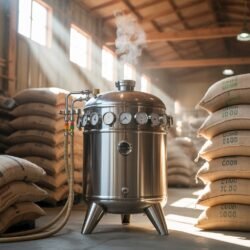The specialty coffee market is evolving rapidly, and one of the most significant trends is the rising demand for anaerobically fermented coffee. This method, which involves fermenting coffee cherries or beans in oxygen-free environments, is capturing the attention of coffee enthusiasts and professionals alike for its unique, complex flavor profiles. But as consumer interest surges, the question arises: how does this trend impact coffee growers, especially those on the frontlines of production?
New Opportunities for Differentiation and Premium Pricing
For coffee growers, the popularity of anaerobic fermentation opens a world of new possibilities. By adopting this innovative processing technique, producers can distinguish their coffee from conventional offerings, targeting specialty buyers who are willing to pay premium prices for unique sensory experiences. Anaerobic coffees often fetch higher prices at auctions and in specialty markets, which can significantly boost income for farms that successfully implement the process.
This trend aligns with the broader specialty coffee movement, where quality, traceability, and innovation are increasingly valued by consumers. For growers, investing in anaerobic fermentation can mean access to new markets and the ability to command prices that reflect the extra effort and expertise required.
Increased Investment and Technical Demands
While the potential rewards are substantial, anaerobic fermentation is not without its challenges. The process requires specialized equipment—such as sealed fermentation tanks, temperature and pH monitoring tools, and sometimes even CO₂ injection systems. For many small-scale producers, the upfront investment in infrastructure and technology can be a significant barrier.
Additionally, anaerobic fermentation demands a high level of technical skill. Growers must carefully control variables like temperature, pH, and fermentation time to avoid off-flavors or spoilage, which can result in the loss of an entire batch. This means that farmers must either develop new expertise or seek out training and support, further increasing the costs and complexity of production.
Financial Risks and Market Volatility
The market for anaerobically fermented coffee is still relatively niche, and demand can be volatile. While some lots command record prices at auctions, not all anaerobically processed coffees achieve the same level of success. Growers may face uncertainty about whether their investment will pay off, especially if consumer preferences shift or if the market becomes saturated with similar products.
There is also the risk of contamination or process failure, which can lead to significant financial losses. Anaerobic environments can foster the growth of undesirable microorganisms if not managed properly, making strict hygiene and monitoring essential.
Labor and Sustainability Considerations
Anaerobic fermentation is often more labor-intensive than traditional methods, requiring additional hands-on work for monitoring, sampling, and processing. This can increase labor costs and place additional strain on farm operations, particularly during peak harvest times.
From a sustainability perspective, anaerobic fermentation can offer some advantages, such as reduced water usage compared to traditional washed processing. However, the increased energy requirements for temperature control and the need for specialized equipment may offset some of these benefits. Growers must carefully weigh the environmental impact of their chosen processing methods against the potential for higher returns.
The Broader Impact on Coffee Communities
For coffee-growing communities, the rise of anaerobic fermentation can be transformative. Successful adoption of the technique can lead to improved livelihoods, as farmers gain access to premium markets and higher incomes. This, in turn, can support community development, education, and infrastructure improvements.
However, the benefits are not guaranteed for all. Small-scale farmers with limited resources may struggle to compete with larger, more established producers who can afford to invest in the necessary technology and training. This could exacerbate existing inequalities within the coffee sector unless targeted support and capacity-building initiatives are put in place.
Looking Ahead: Balancing Innovation with Sustainability
As the popularity of anaerobically fermented coffee continues to grow, it is essential for the industry to support growers in navigating the challenges and opportunities that come with this trend. This includes providing access to training, financing, and technical assistance, as well as promoting sustainable practices that minimize environmental impact.
Ultimately, the increasing demand for anaerobically fermented coffee has the potential to drive positive change in the coffee sector, rewarding innovation and quality while encouraging sustainable production. However, for these benefits to be realized across the board, the industry must ensure that all growers—regardless of size or resources—have the opportunity to participate and succeed.
Conclusion
The surging popularity of anaerobically fermented coffee is reshaping the specialty coffee landscape, offering growers new opportunities for differentiation and premium pricing. However, it also introduces significant challenges, including increased investment, technical demands, and market volatility. By addressing these challenges and promoting inclusive, sustainable growth, the coffee industry can ensure that the benefits of this exciting trend are shared widely among coffee growers around the world.


